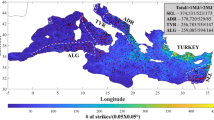Abstract
ALTHOUGH dissolved substances affect the thermodynamic properties of lake waters,1,2 many limnologists still consider lake water as pure water3–8. This can be a good assumption if used with caution: lake water is by no means pure water, especially when the precise pressure, volume, temperature (PVT) properties are considered. PVT properties of lake water can be determined from an equation of state for sea water provided that the total mass fraction of dissolved salts in seawater and lake water are equated9. In addition, the total mass fraction of dissolved salts affects calculations concerning the temperature of maximum density and thus stability10. Therefore, in the absence of direct PVT measurements on a particular lake, it is at present most appropriate to use an equation of state for seawater when examining effects of PVT properties in lakes. We present here a short equation of state determined with a precision of 2 × 10−6 g cm−3 in density over the appropriate range for most fresh water lakes, 0–0.6‰ salinity, 0–30 °C, and 0–180 bar. The equation of state is based on the 1 atm pure water density and compressibility equations of Kell11, the pure water temperature and pressure effects of Fine and Millero12, and the effects of dissolved salts of Millero et al.13 and Chen and Millero14: 

 where dp and d0 are the densities of lake water at applied pressures P and 0 (sea level), respectively, t is the temperature in °C, S(‰) is the salinity:
where dp and d0 are the densities of lake water at applied pressures P and 0 (sea level), respectively, t is the temperature in °C, S(‰) is the salinity:  where gT is the total grams of dissolved salt in 1 kg of lake water15. The values of gT usually increase with depth due to the increase of HCO3−, Ca2+ and nutrients16. The small changes in composition in a lake can be accounted for by making the appropriate changes in gt. Further, Millero9 and Millero et al.17 showed that the densities calculated from the seawater equation of state for Lake Tanganyika water and artificial river water agree with the measured values to within ±2×10−6g cm−3 despite the large composition difference between the two waters. This verifies the validity of our equation of state for fresh waters.
where gT is the total grams of dissolved salt in 1 kg of lake water15. The values of gT usually increase with depth due to the increase of HCO3−, Ca2+ and nutrients16. The small changes in composition in a lake can be accounted for by making the appropriate changes in gt. Further, Millero9 and Millero et al.17 showed that the densities calculated from the seawater equation of state for Lake Tanganyika water and artificial river water agree with the measured values to within ±2×10−6g cm−3 despite the large composition difference between the two waters. This verifies the validity of our equation of state for fresh waters.
This is a preview of subscription content, access via your institution
Access options
Subscribe to this journal
Receive 51 print issues and online access
$199.00 per year
only $3.90 per issue
Buy this article
- Purchase on Springer Link
- Instant access to full article PDF
Prices may be subject to local taxes which are calculated during checkout
Similar content being viewed by others
References
Hutchinson, G. E. Treatise on Limnology 1, (Wiley, New York, 1957).
Lee, A. H. & Rodgers, G. K. Limnol. Oceanogr. 19, 546 (1974).
Strom, K. M. Geofys. Publr 16, No. 8 (1945).
Eklund, H. Science 142, 1457–1458 (1963).
Eklund, H. Science 149, 632–633 (1965).
Lee, A. H. & Rodgers, G. K. Limnol. Oceanogr. 17, 672–677 (1972).
Osborn, T. R. & LeBlond, P. H. Limnol. Oceanogr. 19, 544–545 (1974).
Farmer, D. M. Limnol. Oceanogr. 20, 634–635 (1975).
Millero, F. J. Earth planet. Sci. Lett. (in the press).
Chen, C. T. & Millero, F. J. Limnol. Oceanogr. 22, 158–159 (1977).
Kell, G. S. J. chem. Engng Data 20, 97–105 (1975).
Fine, R. A. & Millero, F. J. J. chem. Phys. 59, 5529–5536 (1973).
Millero, F. J., Gonzales, A. & Ward, G. K. J. mar. Res. 34, 61–93; 34, 497 (1976).
Chen, C. T. & Millero, F. J. Deep Sea Res. 23, 595–612 (1976).
Millero, F. J. in The Oceans Handbook, (ed. Horne, R. A.) (Marcel Dekker, New York, in the press).
Edmond, J. in Lake Tanganyika Geochemical and Hydrographic Study (ed. Craig, H.) SIO Ref. Ser. 75–5, (University of California at San Diego, 1974).
Millero, F. J., Lawson, D. & Gonzalez, A. J. Geophys. Res. 81, 1177–1179 (1976).
Author information
Authors and Affiliations
Rights and permissions
About this article
Cite this article
CHEN, CT., MILLERO, F. The use and misuse of pure water PVT properties for lake waters. Nature 266, 707–708 (1977). https://doi.org/10.1038/266707a0
Received:
Accepted:
Issue Date:
DOI: https://doi.org/10.1038/266707a0
This article is cited by
-
Persistent weak thermal stratification inhibits mixing in the epilimnion of north-temperate Lake Opeongo, Canada
Aquatic Sciences (2014)
-
Volume study on the exclusion of lithium naphthylsulfonate from lithium decylsulfonate micelles
Colloid and Polymer Science (2007)
-
Evolution of temperature and salt structure of Lake Bonney, a chemically stratified Antarctic lake
Hydrobiologia (1996)
-
Volumetric behavior and micelle formation of aqueous surfactant mixtures
Journal of Solution Chemistry (1990)
-
The impact of a chlor-alkali plant on Onondaga Lake and adjoining systems
Water, Air, and Soil Pollution (1987)
Comments
By submitting a comment you agree to abide by our Terms and Community Guidelines. If you find something abusive or that does not comply with our terms or guidelines please flag it as inappropriate.



